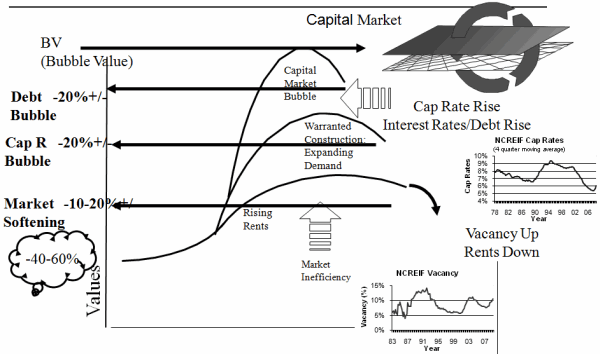|
Question Topic. Real Estate Cycles.We are hearing a lot of talk about real estate cycles and the Spatial/Capital market disconnect. Why do we have cycles in real estate and is real estate cyclical or countercyclical with respect to the broader economy?
DrD's Answer
The Spatial/Capital Market Disconnect
You actually pose two related, but distinct, questions. With respect to the driver behind real estate cycles, the phenomenon can be explained by some of the idiosyncrasies of the
asset class. First of all, real estate is
capital-intensive and durable; it costs a lot and lasts a long time. To achieve scale, many developers focus on larger projects which, by definition, can create short-term surges in supply. This is exacerbated by the fact that developers, investors and lenders often work in a herd fashion which can lead to multiple projects being built in close proximity and time. Second, due to the multidimensional nature of real estate (i.e.,
static,
environmental and
linkages attributes) and its fixed location, real estate is subject to a number of external forces which can exert systematic pressures on the real estate market and change over time. These forces include the broader macroeconomic environment, capital markets and spatial markets. Each of these forces has a temporal nature which leads to market cycles characterized by periods of excesses or shortages of space, both relatively and in absolute terms. Since some of these forces are correlated, they can put pressure on the nature ebb and flow of markets and add to the amplitude and frequency of market cycles or waves. One of the more recent
externalities; is the surge in capital flows to the asset class which led to imbalances on the supply/demand side of the equation, as well as on the pricing. This latter occurred as a result of shortages of investable product which, due to the lags in construction and supply, created upward pressure on prices for existing assets and declining yields. In essence, it created a Spatial/Capital market disconnect that lead to a capital market-driven pricing bubble. Going forward, we are likely to be facing a prolonged period of heightened cycles, both in terms of frequency and severity.

The Reconnect
Once the real estate cycle has peaked, the forces that created the
bubble begin to waiver and values begin to fall back to more reasonable and sustainable levels. This is characterized in the following exhibit which illustrates the potential deflation in value associated with capital withdrawal, declining demand and correction of the lags due to market inefficiency.
With the withdrawal of capital, we are looking at something around a 20% correction; with repricing and rising cap rates associated with greater recognition of risk, another 20% loss; and, with deteriorating fundamentals of supply and demand for space, another 10-20% value loss. In all, we could be looking at value losses in the 50-60% range, dragging down values of solid properties that had benefited from inflated, but unsustainable, price rises leading to the peak in 2008. 
The Countercyclical Nature of Real Estate
The second part of your question is somewhat related, but actually has more to do with lead and lag between when shifts occur in demand for space and the supply of new space. Unlike many other asset classes, the production --or renovation for that matter-- of real estate is time intensive. In some cases, this situation has become more pronounced as the
entitlement process (i.e., getting permits and rezoning) has become more difficult. On the other hand, the economic environment can shift rather quickly as exhibited in the recession that began in 2007 and continues through much of 2009. During this same period of economic contraction, the commercial real estate market seemed somewhat immune, with many hoping the economy would rebound before rippling over to real estate. Unfortunately, the commercial real estate market continued to power forward, led by a surplus of capital chasing opportunities. This overexuberance led to rising prices, lowering yields and a lack of appreciation for risk as new sources of capital not aware of the cyclical nature of real estate were drawn into the fray like flies to a fire. Using another animal analogy, in the current market, many investors and players are like deer staring in the lights of an on-coming car; they know they should move but don't know which way to go. This has helped the market shut down, creating more cyclical downward pressure that will play out for some time. |

